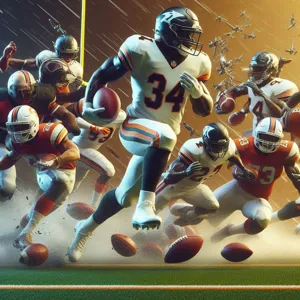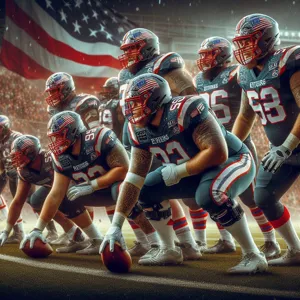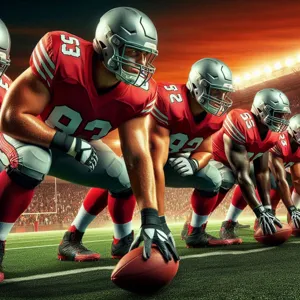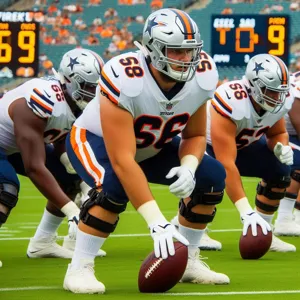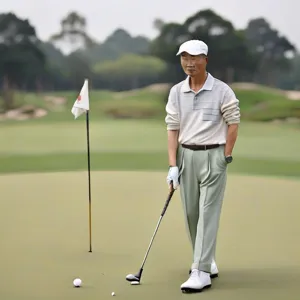In the world of American football, the quarterback stands as a pivotal figure, often viewed as the linchpin of both the team’s performance and its dynamics.
With the ability to read defenses, make split-second decisions, and inspire teammates, the quarterback’s role extends far beyond simply throwing passes or orchestrating plays; it embodies the essence of leadership itself. This blog post delves into “The Quarterback Effect,” exploring how the leadership qualities and strategic acumen of these athletes directly influence team success both on and off the field. By unpacking the traits that define effective quarterbacks—such as resilience, communication, and vision—we’ll uncover the critical lessons that can be applied to any group striving for success. Join us as we examine the intricate relationship between leadership and teamwork, and discover how the principles of the quarterback can empower not just football teams, but any organization aiming to reach its fullest potential.
1. Introduction to the Quarterback Effect

In the high-stakes arena of American football, the term “quarterback” is synonymous with leadership, strategy, and the pivotal role of teamwork. The quarterback effect refers to the profound impact that a skilled quarterback can have not only on the game itself but also on the dynamics of the entire team. This phenomenon transcends mere statistics; it encompasses the intangible qualities that define leadership, resilience, and the ability to inspire.
At the heart of this effect lies the quarterback’s unique position on the field. As the leader of the offense, the quarterback is responsible for orchestrating plays, making split-second decisions, and communicating effectively with teammates. This role demands not just athletic prowess, but also a deep understanding of the game and its nuances. A great quarterback can read defenses, anticipate opponents’ moves, and adjust strategies in real-time, all while maintaining composure under pressure.
Beyond the X’s and O’s of the game, the quarterback’s influence extends to team morale and chemistry. A confident and charismatic leader can uplift teammates, instilling a sense of unity and purpose. This is particularly crucial during challenging moments, whether it’s a late-game situation where the outcome hangs in the balance or a season marked by setbacks. The quarterback’s demeanor often sets the tone for the rest of the team, fostering an environment where players feel empowered to excel and contribute to a collective goal.
As we delve into the intricacies of the quarterback effect, we’ll explore how this pivotal role shapes not only individual performance but also the overall success of the team. From legendary quarterbacks who have left their mark on the game to emerging stars redefining what it means to lead, this examination reveals the multifaceted nature of leadership in American football and its lasting impact on the sport. Join us as we unpack the quarterback effect and its implications for teamwork, strategy, and success both on and off the field.
2. The Role of the Quarterback in Team Dynamics
In the intricate dance of American football, the quarterback emerges as not just a key player, but the linchpin of team dynamics. This pivotal position is often characterized by a unique blend of physical prowess, mental acuity, and interpersonal skills that can significantly influence the overall performance of the team. The quarterback is tasked with more than simply throwing the ball; they serve as the field general, orchestrating plays and making split-second decisions that can alter the course of a game.
From the moment the ball is snapped, the quarterback must assess the field—an array of moving parts, from offensive linemen forming a protective wall to receivers darting towards open space. Their ability to read defenses and anticipate plays is crucial; a quarterback must quickly decipher movements and adjust strategies on the fly, demonstrating a high level of situational awareness. This skill not only requires a deep understanding of the game but also the ability to remain calm under pressure, making the quarterback’s mental fortitude a vital component of team dynamics.
Moreover, the quarterback’s influence extends beyond the X’s and O’s of the game. They are often seen as the emotional leader of the team, responsible for fostering cohesion and unity among players. Strong communication skills are essential; a quarterback must effectively convey strategies to teammates, rally them during difficult moments, and maintain morale throughout the ups and downs of a season. This leadership role cultivates trust and respect, enabling players to perform at their best, knowing they have a reliable leader guiding them.
In essence, the role of the quarterback transcends athletic ability. It encapsulates the essence of teamwork, resilience, and strategic thinking. By nurturing strong relationships with teammates and understanding the intricacies of their roles, a quarterback can elevate not just their own performance, but that of the entire team. This multifaceted role highlights why the quarterback is often regarded as one of the most crucial figures in American football, embodying the spirit of leadership that drives team success.
3. Key Traits of Successful Quarterbacks

Successful quarterbacks possess a unique blend of traits that set them apart as leaders on and off the field. These attributes not only contribute to their individual performance but also play a crucial role in galvanizing their teammates.
**1. Vision and Awareness:** One of the most vital traits of a successful quarterback is an exceptional field vision. Great quarterbacks can read defenses like an open book, anticipating player movements and identifying opportunities before they fully materialize. This ability to see the game unfold allows them to make split-second decisions that can change the course of a play, reflecting a deep understanding of both their team’s strengths and the opponent’s weaknesses.
**2. Communication Skills:** Effective communication is paramount for a quarterback. They must convey complex strategies to their teammates in an understandable manner, ensuring everyone is on the same page. This includes not only vocal commands but also body language and non-verbal cues that help create a cohesive unit. A quarterback who can foster open dialogue and encourage feedback creates an atmosphere of trust and collaboration.
**3. Composure Under Pressure:** The quarterback often finds themselves in high-stakes situations where the pressure can be overwhelming. Successful quarterbacks maintain their composure, exhibiting poise even when the game hangs in the balance. This calmness not only inspires confidence among teammates but also allows them to execute plays effectively, regardless of the intensity of the moment.
**4. Work Ethic and Commitment:** A strong work ethic is essential for any leader, and quarterbacks are no exception. They dedicate countless hours to studying game film, refining their skills, and understanding their opponents. This commitment to continuous improvement not only enhances their performance but also sets a standard for the entire team, motivating others to elevate their level of play.
**5. Resilience and Adaptability:** Football is an unpredictable game, and successful quarterbacks must be resilient in the face of adversity. Whether it’s a tough loss, a critical mistake, or a sudden change in game plan, the ability to bounce back and adapt is crucial. This resilience not only helps them navigate challenges but also instills a sense of determination in their teammates, reinforcing the belief that they can overcome any obstacle together.
In summary, the key traits of successful quarterbacks—vision and awareness, communication skills, composure under pressure, work ethic, and resilience—are essential not just for individual success but for fostering a winning team culture. These qualities enable quarterbacks to lead with confidence, inspiring their teammates to strive for greatness and achieve collective success on the field.
4. Leadership Styles: How Quarterbacks Inspire Teams
In the high-stakes world of American football, the quarterback often serves as the heartbeat of the team, embodying a unique blend of leadership qualities that inspire both confidence and camaraderie among players. Their influence extends far beyond the huddle; it permeates the locker room and resonates throughout every play on the field. Understanding the leadership styles of quarterbacks reveals how they galvanize their teammates and create a winning culture.
One of the most prominent leadership styles exhibited by quarterbacks is the **transformational approach**. These leaders are visionaries, able to articulate a clear and compelling vision of success that motivates their teammates to strive for excellence. They possess an innate ability to uplift their teammates, fostering a sense of unity and shared purpose. For instance, a quarterback who rallies his team with an impassioned speech before a crucial game can ignite a fire within each player, encouraging them to push beyond their limits.
In contrast, some quarterbacks adopt a more **transactional leadership style**, focusing on setting clear expectations and rewarding team members for meeting specific goals. This approach creates a structured environment where players understand their roles and responsibilities, reinforcing discipline and accountability. A quarterback who consistently recognizes and rewards individual efforts—whether through a simple pat on the back or a shout-out in the locker room—can cultivate a strong sense of loyalty and drive among teammates.
Additionally, the **emotional intelligence** displayed by many successful quarterbacks enhances their leadership effectiveness. By demonstrating empathy and understanding, they can connect with teammates on a personal level, allowing for open communication and trust. This emotional bond not only strengthens team dynamics but also encourages players to support one another, even in the face of adversity. A quarterback who acknowledges a teammate’s struggles and offers encouragement can create an environment where players feel valued and motivated to give their best.
Ultimately, the leadership styles of quarterbacks are pivotal in shaping team culture and performance. Whether through inspirational speeches, structured expectations, or emotional connections, these leaders have the power to transform a group of individuals into a cohesive unit. As we unpack the nuances of their leadership, it becomes evident that the quarterback’s role extends far beyond calling plays; they are the architects of teamwork and success on the gridiron.
5. The Impact of Quarterback Performance on Game Outcomes

The quarterback is often heralded as the linchpin of an American football team, and for good reason. Their performance on the field can significantly sway the outcome of a game, making the quarterback position one of the most scrutinized roles in sports. When a quarterback takes the snap, they are not just executing plays; they are orchestrating the entire offense, reading the defense, and making split-second decisions that can lead to touchdowns or turnovers.
A quarterback’s ability to read the game is paramount. They must quickly analyze defensive formations, anticipate player movements, and decide whether to pass, run, or hand off the ball. This mental acuity is just as vital as physical prowess. A quarterback with a keen eye can exploit defensive weaknesses, turning potential losses into game-changing plays. For instance, a perfectly timed throw that splits two defenders can result in a long touchdown pass, igniting the team and energizing the crowd. Conversely, a poorly executed pass can lead to interceptions, shifting momentum to the opposing team and demoralizing their own players.
Statistics often reflect this impact: a high quarterback rating typically correlates with team success. Games can pivot on a single moment—a last-minute drive led by a cool-headed quarterback can secure a win, while a series of missteps can lead to defeat. Furthermore, the psychological factor cannot be overlooked. A confident quarterback can uplift team morale, inspiring their teammates to perform at their best, while a struggling quarterback may inadvertently create doubt and tension within the locker room.
The relationship between a quarterback and their offensive line also plays a critical role. A quarterback who enjoys strong protection is more likely to execute successful plays, while one who faces constant pressure can become rattled, leading to mistakes. This synergy highlights the importance of teamwork, as the quarterback’s success is often a reflection of collective efforts.
In summary, the performance of a quarterback is a pivotal element in determining game outcomes. Their ability to lead, adapt, and execute under pressure is what often separates victorious teams from those who fall short. Understanding this dynamic not only enriches our appreciation of the game but also sheds light on the intricate dance of leadership and teamwork in American football.
6. Case Studies: Legendary Quarterbacks and Their Leadership
In the realm of American football, the quarterback is often likened to a general leading troops into battle. Their ability to instill confidence, rally teammates, and execute game strategies can define the trajectory of a season. To illustrate the profound impact of quarterback leadership, let’s delve into a few legendary figures whose careers showcase the essence of strong leadership on and off the field.
**Joe Montana** stands as a paragon of composure and precision. His tenure with the San Francisco 49ers was marked by clutch performances in critical moments, earning him four Super Bowl titles. Montana’s leadership style was characterized by a calm demeanor, exuding confidence even in high-pressure situations. Teammates often spoke of his ability to connect on a personal level, fostering trust that transcended the field. His famous game-winning drive in Super Bowl XXIII against the Cincinnati Bengals is a testament to his capacity to inspire those around him, turning pressure into opportunity.
**Tom Brady**, often hailed as the greatest quarterback of all time, redefined expectations for leadership in the NFL. His relentless work ethic and attention to detail set a standard for teammates, pushing them to elevate their own performance. Brady’s ability to communicate effectively, both in the huddle and through his meticulous preparation, created a culture of accountability. Notably, his comeback victory in Super Bowl LI against the Atlanta Falcons—where the New England Patriots overcame a 28-3 deficit—exemplifies his unyielding belief in the team’s potential, rallying his players to achieve the impossible.
**Peyton Manning**, known for his cerebral approach to the game, brought a different flavor to quarterback leadership. His proficiency in reading defenses and making audibles at the line of scrimmage demonstrated not just his individual skill but also his responsibility to empower his teammates. Manning’s charisma and commitment to preparation helped cultivate an environment where players felt equally invested in the team’s success. His two Super Bowl victories, particularly the one with the Denver Broncos in Super Bowl 50, were more than just personal achievements; they were a culmination of his ability to galvanize an entire organization around a shared vision.
These case studies underscore a pivotal truth: While raw talent can win games, it is the leadership qualities embodied by these quarterbacks that forge resilient teams capable of sustained success. Their stories remind us that in the high-stakes arena of American football, effective leadership is the secret sauce that transforms a group of talented individuals into a cohesive unit, ready to face any challenge head-on.
7. Communication: The Quarterback’s Role in Team Cohesion

In the high-stakes world of American football, the quarterback stands as the linchpin of team cohesion, seamlessly weaving together the diverse talents and personalities on the field. Beyond their physical prowess, it is their communication skills that elevate them from mere players to effective leaders. The quarterback is not just the individual calling plays; they are the voice that resonates through the huddle, delivering both strategic direction and motivational encouragement.
Effective communication begins with clarity. A successful quarterback must articulate plays succinctly, ensuring that each teammate understands their role and responsibilities. This clarity fosters trust and minimizes confusion, allowing the team to execute complex strategies with precision. Moreover, the quarterback’s ability to read the game and communicate adjustments on the fly is crucial. Whether it’s altering a play based on defensive formations or signaling a last-minute change, their quick decision-making and clear delivery can turn the tide of a game.
However, communication in football extends far beyond mere instructions. It encompasses the emotional intelligence necessary to connect with teammates on a personal level. A great quarterback understands the pressures each player faces and takes the time to listen and empathize. This rapport fosters an environment of mutual respect and support, creating a team culture where every member feels valued and motivated to contribute their best effort.
In practice, this means engaging in open dialogues, encouraging feedback, and building camaraderie. Quarterbacks often organize team activities outside of practice, strengthening relationships and enhancing communication lines. By investing in these connections, they cultivate a cohesive unit that thrives on collaboration and shared goals.
Moreover, effective communication is vital during high-pressure situations. The quarterback’s calm demeanor and authoritative voice in crucial moments—like during a two-minute drill—can inspire confidence among teammates, transforming anxiety into action. When players trust their quarterback’s judgment and feel connected to their leader, they are more likely to perform at their peak, even when the stakes are highest.
Ultimately, the quarterback’s role in team cohesion transcends the field. Through clear, empathetic communication and a commitment to fostering relationships, they not only drive the strategic execution of plays but also cultivate a spirit of unity and resilience. This dynamic leadership is what truly embodies the essence of the game, reminding us that success in football, much like in any team endeavor, hinges on the power of connection and collaboration.
8. The Psychological Aspects of Quarterback Leadership
The role of a quarterback extends far beyond the physical skills required to throw a perfect spiral or read a defense; it encompasses a complex web of psychological attributes that can significantly influence team dynamics and overall success. A quarterback is often viewed as the on-field leader, a position that demands not only technical prowess but also emotional intelligence, resilience, and the ability to inspire those around them.
One of the most critical psychological aspects of quarterback leadership is confidence. A successful quarterback exudes an air of assurance that can permeate the locker room and the field. This confidence fosters trust among teammates, allowing them to perform at their best without hesitation. When a quarterback believes in their abilities and the game plan, it instills a similar belief in the rest of the team, cultivating a culture of positivity and determination.
Communication is another vital facet of quarterback leadership. The quarterback must effectively convey strategies and adjustments to teammates, often in high-pressure situations. This requires not only clarity and decisiveness but also active listening. A quarterback who understands the concerns and strengths of their teammates can tailor their approach, ensuring everyone is on the same page. This two-way communication builds rapport and creates a cohesive unit, essential for executing plays seamlessly during critical moments.
Moreover, mental toughness is paramount. Quarterbacks frequently face immense pressure, especially during high-stakes games. The ability to remain calm under pressure, bounce back from mistakes, and maintain focus is crucial. This mental resilience not only affects the quarterback’s performance but also sets the tone for the entire team. When teammates see their leader remain composed in adversity, they are more likely to mirror that behavior, collectively rising to meet challenges head-on.
Lastly, emotional intelligence plays a significant role in quarterback leadership. Understanding the emotional states of teammates and responding accordingly can make a profound difference. A quarterback who can read the room, offer encouragement when morale is low, or challenge teammates when they need a push can harness the emotional energy of the team to fuel performance. This ability to connect on a personal level enhances team cohesion and fosters an environment where players feel valued and motivated.
In essence, the psychological aspects of quarterback leadership weave a rich tapestry that significantly impacts team success. By cultivating confidence, mastering communication, demonstrating mental toughness, and exercising emotional intelligence, quarterbacks can lead their teams not just on the field but in the hearts and minds of their fellow players, creating a lasting legacy of leadership that echoes through the annals of American football.
9. Developing Future Quarterbacks: Training and Mentorship
In the realm of American football, the quarterback is often seen as the linchpin of the team—an individual whose decisions and leadership can make or break a game. However, the sustainability and success of any football program hinge not only on the current roster but also on the cultivation of future quarterbacks. Developing future quarterbacks through intentional training and mentorship is essential for ensuring a team’s long-term success.
Effective training begins with a deep understanding of the fundamentals. This encompasses not just the technical skills of throwing, footwork, and reading defenses, but also the mental aspects of the game. Aspiring quarterbacks must learn to analyze game film, recognize patterns, and develop a strategic mindset. Coaches can implement drills that mimic real-game scenarios, allowing young players to practice decision-making under pressure. By fostering a rigorous training environment, teams can equip future quarterbacks with the tools they need to succeed on and off the field.
Mentorship plays a pivotal role in nurturing these young athletes. Established quarterbacks can serve as invaluable resources, sharing their experiences, insights, and lessons learned from both victories and setbacks. This relationship can take many forms—from one-on-one training sessions to informal discussions in the locker room. A mentor can help instill confidence, offer guidance in navigating the complexities of the game, and serve as a role model for professionalism and sportsmanship.
Moreover, creating a positive team culture that emphasizes growth and support is crucial. When young quarterbacks feel encouraged to ask questions and seek advice, they are more likely to develop not only their skills but also their leadership qualities. Emphasizing teamwork and collaboration can help build a strong rapport among players, ultimately fostering a sense of unity that extends beyond the quarterback position.
By investing time and resources into the development of future quarterbacks, teams can create a legacy of excellence on the field. This commitment not only enhances individual player performance but also strengthens the overall team dynamic, paving the way for sustained success in the ever-competitive landscape of American football.
10. The Importance of Offensive Line Support
In the high-octane world of American football, the quarterback often garners the spotlight with their athletic prowess and strategic playmaking. However, behind every successful quarterback lies a robust and skilled offensive line, the unsung heroes of the gridiron. The importance of offensive line support cannot be overstated; they serve as the backbone of the offense, providing the critical protection and time needed for a quarterback to execute plays effectively.
Imagine a quarterback standing in the pocket, surveying the field for an open receiver. Without the solid wall of linemen shielding them from the oncoming defensive rush, that moment of clarity could quickly devolve into chaos. The offensive line is tasked with not only blocking defenders but also creating running lanes for backs and maintaining the overall tempo of the game. Their ability to communicate and function as a cohesive unit often dictates the success of the offensive strategy.
When the offensive line performs well, it allows the quarterback to remain calm under pressure, making split-second decisions that can change the course of a game. Conversely, when that protection falters, even the most talented quarterbacks can struggle, leading to hurried throws, turnovers, or, worse, injuries.
Moreover, the synergy between the quarterback and their offensive line is critical for maintaining a consistent offensive rhythm. A quarterback who trusts their line can focus on reading defenses and executing plays, while a line that understands their quarterback’s tendencies can adjust their blocking schemes accordingly. This mutual reliance fosters an environment where both the quarterback and the line flourish, ultimately contributing to the team’s overall success.
In essence, the offensive line is not just a group of blockers; they are pivotal to the quarterback’s effectiveness and, by extension, the team’s performance. Recognizing and valuing this relationship is essential for any football program aiming for greatness. When evaluating a team’s success, it’s crucial to remember that behind every great quarterback is a sturdy offensive line, tirelessly working to ensure that the spotlight remains not just on the star player, but on the whole team’s achievements.
11. Strategies for Effective Decision-Making on the Field
In the high-stakes world of American football, effective decision-making on the field can mean the difference between victory and defeat. Quarterbacks, often regarded as the leaders of their teams, face an onslaught of choices in mere seconds—each one requiring a blend of instinct, strategy, and situational awareness. To unpack the strategies for effective decision-making in this fast-paced environment, we must consider several key elements that contribute to a quarterback’s success.
Firstly, **read and react** is a fundamental strategy that every quarterback must master. This involves analyzing the defense’s formation and anticipating potential plays before the snap. By studying game film and understanding opponent tendencies, quarterbacks can develop a keen sense of how to exploit defensive weaknesses. This preemptive knowledge allows them to make quicker, more informed decisions on the field, whether it’s opting for a pass, a handoff, or a scramble.
Another crucial aspect is **communication with the team**. Successful quarterbacks foster a strong rapport with their offensive linemen and receivers, ensuring that everyone is on the same page. This collaboration is vital during high-pressure moments when split-second decisions are necessary. Clear signals, a well-practiced cadence, and even non-verbal cues can enhance the team’s ability to react cohesively to changing situations on the field.
Additionally, **embracing situational awareness** is paramount. A quarterback must understand the context of the game—time left on the clock, score, field position, and team momentum. This awareness shapes their decision-making process, guiding them to choose plays that align with the strategic goals of the moment. For instance, during a two-minute drill, urgency takes precedence over risk, pushing the quarterback to prioritize efficiency and accuracy over flashy plays.
Furthermore, **trusting instincts** developed through experience can be a game-changer. While preparation is crucial, the ability to pivot when unexpected challenges arise is just as important. Top quarterbacks learn to blend their training with their gut feelings, often making audibles or changing plays on the fly when they sense an opportunity or threat.
Lastly, **post-game analysis** plays a vital role in refining decision-making skills. Reviewing game footage allows quarterbacks to assess their choices, learn from mistakes, and reinforce successful strategies. This continuous feedback loop ensures that they are always evolving, ready to adapt in future games.
In conclusion, effective decision-making on the football field is a multifaceted skill that combines preparation, communication, situational awareness, instinct, and reflection. By honing these strategies, quarterbacks not only enhance their performance but also elevate their entire team’s success, embodying the essence of leadership in American football.
12. Analyzing Team Success: Is it Just the Quarterback?
When it comes to analyzing team success in American football, the spotlight often shines brightest on the quarterback. This pivotal role, often viewed as the lynchpin of a team’s performance, brings with it a unique blend of responsibility, talent, and pressure. But is it fair to attribute a team’s success solely to the quarterback? The answer, as many analysts and fans have debated, is a resounding no.
While a skilled quarterback can certainly elevate a team’s performance, football is inherently a collective endeavor. The quarterback may command the field and orchestrate plays, but the success of those plays relies heavily on a cohesive unit of players. The offensive line, for instance, must provide the necessary protection against relentless defensive pressure, allowing the quarterback time to make decisions. Similarly, wide receivers need to execute precise routes to create opportunities for successful passes. When these elements align, magic can happen, but when they falter, even the most talented quarterback can struggle.
Moreover, the defense plays an equally crucial role in a team’s overall success. A robust defensive strategy can alleviate pressure on the offense by limiting the opponent’s scoring opportunities. Teams with a strong defense often find themselves in advantageous positions, allowing their quarterbacks to manage the game more effectively.
In addition, coaching strategies and team culture significantly influence performance. A coach’s ability to foster teamwork, adaptability, and resilience can propel a team to new heights, often overshadowing individual contributions. It’s the synergy between the quarterback and the supporting cast, combined with effective coaching, that truly defines a team’s success on the field.
Ultimately, while the quarterback is undeniably a key figure, it is the interplay of all team members—offensive and defensive players alike—that crafts the narrative of a season. It’s a collective journey towards victory, where every player, regardless of position, must contribute to the greater goal. In exploring the quarterback effect, it’s essential to recognize that success in American football is far more than just one person’s achievements; it is a testament to teamwork, strategy, and shared aspiration.
13. Lessons from Football: Leadership Principles for Other Fields
American football, with its high-stakes environment and complex dynamics, offers a treasure trove of leadership lessons that extend far beyond the gridiron. At its core, the game is a microcosm of teamwork, strategy, and resilience—qualities that are equally vital in business, education, and various other fields.
One of the most profound principles gleaned from football is the importance of clear communication. On the field, a quarterback must convey plays, adjustments, and motivation in a split second, ensuring that every player is on the same page. This level of clarity and decisiveness is crucial in any leadership role. Whether you’re managing a team or leading a project, fostering an environment where open dialogue is encouraged can significantly enhance collaboration and effectiveness.
Another valuable lesson is the significance of adaptability. Football teams often face unexpected challenges—be it an injury to a key player or an unforeseen strategy from the opposing team. A successful quarterback must not only anticipate these changes but also adjust the game plan accordingly. In the workplace, leaders can draw parallels by remaining flexible and open to new ideas, allowing them to pivot in response to market changes or team dynamics.
Moreover, the concept of accountability rings true in both football and leadership. A quarterback takes responsibility for the team’s performance, whether it’s a win or a loss. In the same vein, effective leaders must own their decisions and inspire their teams to do the same. By fostering a culture of accountability, leaders empower their team members to take initiative and learn from their mistakes, ultimately driving collective growth.
Lastly, the essence of building trust cannot be overstated. In football, trust among teammates translates to seamless coordination and confidence in one another’s abilities. Leaders in any field should strive to cultivate trust within their teams by being transparent, supportive, and consistent. When team members believe in their leader and each other, they are more likely to collaborate effectively and push toward shared goals.
In essence, the principles of leadership gleaned from American football—communication, adaptability, accountability, and trust—serve as invaluable guides for success in any field. By embracing these lessons, leaders can build resilient teams, foster a positive culture, and navigate the complexities of their respective industries with confidence.
14. Conclusion: The Lasting Impact of Quarterback Leadership on American Football
In conclusion, the influence of quarterback leadership on American football extends far beyond the confines of the field. A quarterback is not merely a player; they are the linchpin of the team, embodying the spirit, strategy, and resilience that define a successful franchise. Their ability to read the game, make split-second decisions, and inspire teammates is pivotal in shaping the outcome of each play and, ultimately, the season.
The lasting impact of quarterback leadership is evident in the legacies of iconic players such as Tom Brady, Joe Montana, and Johnny Unitas, whose charisma and tactical acumen have not only led their teams to victory but have also set standards in the sport. These leaders create a culture of accountability and excellence, fostering an environment where players are motivated to elevate their performance and embrace their roles within the larger team dynamic.
Moreover, the quarterback’s role transcends the field; they often serve as the face of the franchise, influencing fan engagement, community relations, and the overall brand of the team. Their leadership qualities resonant with fans, creating a deep emotional connection that strengthens the support base and enhances the team’s identity.
As we unpack the quarterback effect, it’s clear that their leadership is a multifaceted phenomenon. It intertwines skill, mental fortitude, and interpersonal dynamics, illustrating that a great quarterback can transform not only a game but an entire organization. Thus, as teams continue to scout and develop their quarterbacks, they must recognize the profound impact these players have on shaping the future of American football, both on and off the field. The legacy of quarterback leadership is not just about the victories; it’s about inspiring the next generation of players and fans, leaving an indelible mark on the sport we love.
15. Resources for Further Reading on Leadership and Team Success
In the pursuit of excellence, understanding the nuances of leadership and team dynamics is paramount, and fortunately, a wealth of resources exists to deepen your knowledge in these areas. Whether you’re a coach, player, or simply an enthusiast of the game, these books, articles, and podcasts can provide valuable insights into the principles that drive successful teams on and off the field.
1. **Books**: Consider diving into classics like “The Five Dysfunctions of a Team” by Patrick Lencioni, which identifies common pitfalls that teams face and offers strategies for overcoming them. Another must-read is “Leaders Eat Last” by Simon Sinek, which explores how great leaders create environments where people feel safe and valued, ultimately leading to higher performance. For a football-centric perspective, “Friday Night Lights” by H.G. Bissinger not only chronicles a high school football team’s journey but also delves into the leadership styles that shape the culture of a team.
2. **Articles**: Websites like Harvard Business Review and Sports Illustrated often publish articles that bridge the gap between sports and leadership theory. Look for pieces on effective communication strategies, motivational techniques, and case studies of successful teams that have thrived under strong leadership.
3. **Podcasts**: Tune into leadership-focused podcasts such as “The Ed Mylett Show” and “The Tim Ferriss Show,” where guests often share their experiences in leadership, including lessons learned from the sports world. Additionally, “The Coaching Habit” podcast offers quick, insightful tips on how to cultivate a coaching mindset that can inspire teams toward success.
4. **Webinars and Workshops**: Many organizations offer webinars and workshops on team dynamics and leadership strategies, often featuring experienced coaches and sports psychologists. These sessions provide practical tools and frameworks that you can apply directly to your own teams, fostering collaboration and enhancing performance.
5. **Documentaries**: Consider watching documentaries like “The Last Dance,” which chronicles Michael Jordan’s career with the Chicago Bulls and highlights the leadership qualities that propelled his team to greatness. Such visual narratives can offer a compelling perspective on the importance of leadership in achieving team success.
By immersing yourself in these resources, you can gain a deeper understanding of what makes effective leaders and how they can cultivate an environment that fosters teamwork, resilience, and triumph. Embrace the knowledge gained from these varied sources, and watch as it transforms your approach to leadership and collaboration, both in football and beyond.
In conclusion, the Quarterback Effect transcends the football field, illuminating the profound impact that effective leadership has on team dynamics and overall success. As we’ve explored throughout this post, a quarterback’s ability to inspire, communicate, and strategize can significantly influence not only the game’s outcome but also the cohesion and morale of the entire team. By understanding the traits that make a successful quarterback—such as resilience, adaptability, and emotional intelligence—leaders in any field can harness these qualities to foster a culture of collaboration and achievement. Whether you’re a coach, a business leader, or simply a fan of the game, embracing the principles behind the Quarterback Effect can lead to transformative results, both on and off the field. So, as you reflect on your own leadership journey, consider how you can embody these essential traits to drive success in your team, just like the great quarterbacks who have left their mark on the game.


